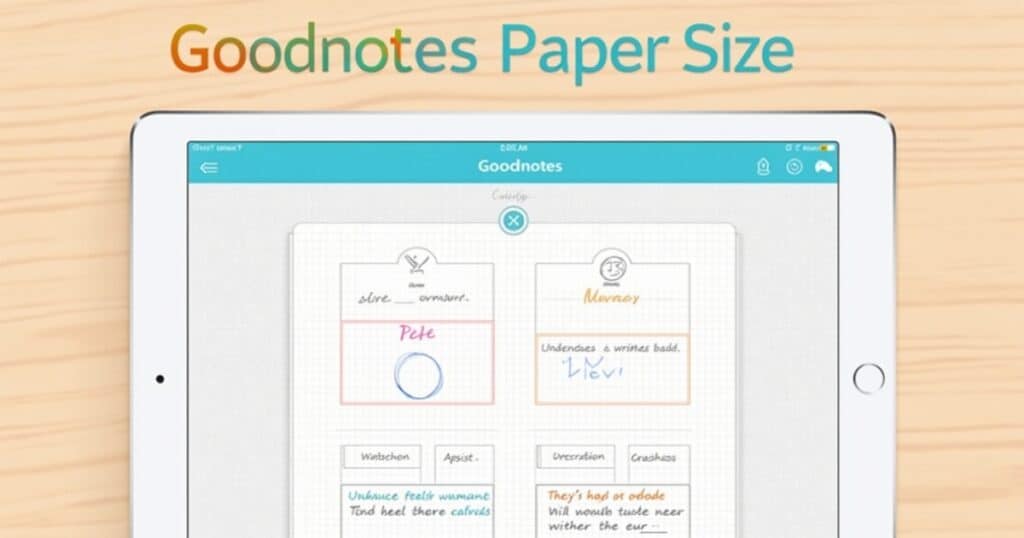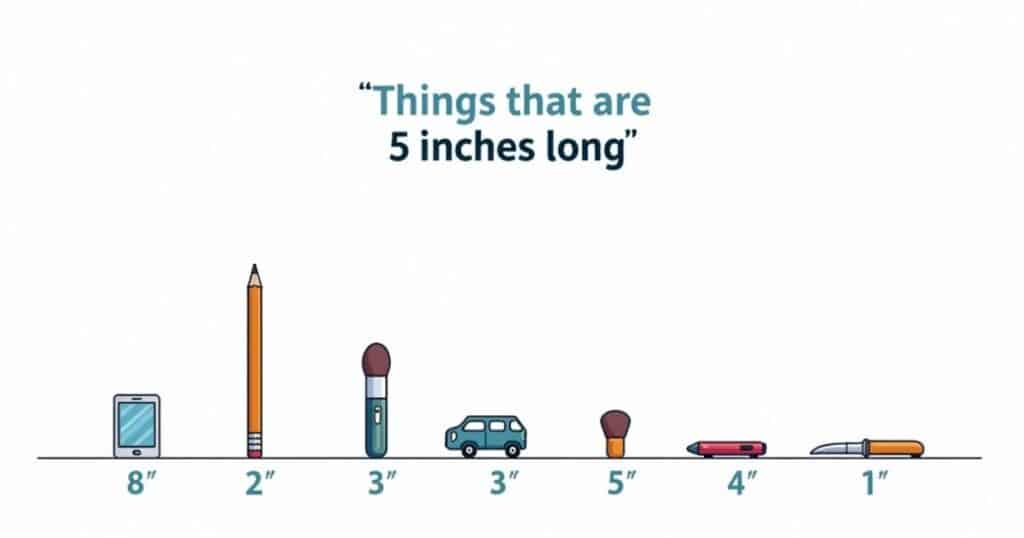Ever found yourself staring at your iPad, wondering which paper size would work best for your digital notes? You’re not alone. Whether you’re a student taking lecture notes, a professional organizing meeting minutes, or an artist sketching ideas, paper size in GoodNotes can make or break your digital note-taking experience.
I’ve spent countless hours testing different GoodNotes paper sizes across various projects. Sometimes I’d finish a complex diagram only to realize the canvas was too small, forcing me to start over. Other times, I’d struggle to navigate an unnecessarily large page on my iPad mini.
In this comprehensive guide, we’ll explore everything you need to know about GoodNotes paper sizes from standard options to custom dimensions helping you choose the perfect canvas for your digital note-taking needs.
What Are the Standard GoodNotes Paper Sizes?
GoodNotes offers several paper sizes that mirror real-world paper standards. The app supports both portrait and landscape orientations for all these sizes:
- US Letter (8.5 × 11 inches) – The standard American paper size
- A4 (210 × 297 mm) – The international standard used in most countries
- A5 (148 × 210 mm) – Half the size of A4, perfect for portable notes
- B5 (176 × 250 mm) – Slightly larger than A5 but smaller than A4
- Square (iPad screen dimensions) – Optimized for the iPad screen
- Custom size – Create your own dimensions for specific needs
Understanding these dimensions helps you select the right canvas size before you dive into creating content saving time and frustration later.
Why Paper Size Matters in Digital Note-Taking
Paper size isn’t just about aesthetics it fundamentally affects your note-taking workflow. Here’s why your choice matters:
1. Readability and Organization
The right paper size creates breathing room between elements, making your notes easier to read and reference later. Too small, and you’ll cram information; too large, and you’ll waste digital space.
For instance, when I switched from US Letter to A5 for my daily planner, I found myself naturally creating more structured, concise notes the limited space forced me to prioritize information.
2. Printing Compatibility
If you plan to print your digital notes, choosing a standard paper size like A4 or US Letter ensures your content appears exactly as intended, without awkward scaling or margins.
3. Device Optimization
Your device’s screen dimensions should influence your paper size choice. On a 12.9-inch iPad Pro, a US Letter size gives plenty of writing space, while on smaller devices like the iPad Mini, A5 might offer better visibility without constant zooming and scrolling.
4. Export Flexibility
When sharing notes with colleagues or classmates, standard paper sizes ensure compatibility across different platforms and applications. I’ve found that A4 works universally when sending PDFs to colleagues using various devices.
Popular GoodNotes Paper Sizes and Their Best Uses
Let’s examine each common paper size and when you might want to use it:
US Letter (8.5 × 11 inches)
This familiar American standard works well for comprehensive note-taking, especially for students and professionals used to this format.
I’ve found US Letter ideal for detailed lecture notes where diagrams, formulas, and extensive text need to coexist on one page. The generous dimensions allow you to create hierarchical structures and visually distinct sections without feeling cramped.
Pro tip: Use US Letter for course notes you might eventually print for review before exams.
A4 (210 × 297 mm)
Slightly taller and narrower than US Letter, A4 is the international standard used throughout most of the world.
A4 excels at formal documentation and professional reports. Its proportions balance readability with space efficiency, making it perfect for business plans, research papers, and detailed project documentation.
Interesting fact: If you fold an A4 sheet in half, you get an A5 all A-series papers maintain the same proportions when halved, a brilliant design feature that dates back to 1786 in Germany.
A5 (148 × 210 mm)
Half the size of A4, this compact format shines for daily planners, quick meeting notes, and personal journaling.
I switched to A5 for my daily task lists and found that the limited space encouraged me to be more concise and thoughtful about what I included. It also reduced scrolling on my iPad during meetings.
When to use it: Choose A5 when portability matters or when you’re working with bite-sized information that doesn’t require extensive diagrams or illustrations.
B5 (176 × 250 mm)
Sitting between A4 and A5, B5 offers a “Goldilocks” solution not too big, not too small.
This size works beautifully for creative writing, journaling, and sketch notes where you want more space than A5 but don’t need the full expanse of A4. Many novelists and writers prefer B5 paper for drafting, as it provides enough room for margin notes while maintaining a comfortable writing area.
Did you know? B-series paper sizes were originally designed in Japan for books and posters, explaining why they’re particularly suitable for creative work.
Square (iPad screen dimensions)
GoodNotes offers a square paper option that matches your iPad’s screen proportions, eliminating the need to scroll horizontally or vertically.
This format works exceptionally well for mind maps, concept diagrams, and visual brainstorming sessions. I’ve used square paper for project planning, where connecting ideas in multiple directions feels more natural than working within rectangular constraints.
Creative application: Try square paper for Cornell-style notes, dedicating different quadrants to different types of information.
Custom Sizes
GoodNotes allows you to create custom paper sizes for specialized needs.
When preparing presentation slides in GoodNotes, I often use a custom 16:9 ratio (matching standard display dimensions) to ensure my hand-drawn slides will project correctly without distortion.
Practical use: Consider custom sizing for specialized projects like greeting card designs, flashcards, or storyboarding.

How to Choose the Right Paper Size for Different Uses
Your choice of paper size should align with your specific note-taking goals:
For Students
- Lecture Notes: US Letter or A4 provides ample space for comprehensive subject notes.
- Quick Study Guides: A5 works well for condensed review materials.
- Language Learning: B5 offers sufficient room for vocabulary lists with translations.
For Professionals
- Meeting Notes: A5 keeps things concise and focused.
- Project Planning: Square format facilitates non-linear thinking.
- Client Presentations: Custom 16:9 ratio ensures projection-ready content.
For Creatives
- Sketching: Square or A4 landscape gives maximum flexibility.
- Journaling: A5 or B5 feels intimate and manageable.
- Storyboarding: Custom sizes matching your final output dimensions.
Creating Custom Templates with the Perfect Paper Size
GoodNotes really shines when you combine the right paper size with custom templates. Here’s how to maximize your efficiency:
- Identify your most common use cases – Do you primarily take lecture notes, plan projects, or sketch ideas?
- Create templates at the ideal size – Design or import templates sized appropriately for each activity.
- Save to your template library – Store your perfectly sized templates for quick access.
For example, I’ve created an A5 weekly planner template, a US Letter lecture notes template with Cornell method formatting, and a square brainstorming template each optimized for its specific purpose.
See Also: Running Track Sizes: Everything You Need to Know
Tips for Managing Multiple Paper Sizes in Your Notebooks
Working with different paper sizes in GoodNotes requires some organization:
Use Notebook Covers as Size Indicators
Create distinctive cover designs for different-sized notebooks. I use blue covers for A4, green for A5, and orange for custom sizes making them instantly recognizable in my library.
Create Size-Specific Folders
Organize your notebooks into folders based on size or purpose. This prevents the jarring experience of switching between differently sized notebooks during a study or work session.
Standardize When Collaborating
When sharing notes with colleagues or classmates, stick to standard sizes like A4 or US Letter to ensure compatibility across different devices and potential printing needs.
Paper Size and Digital Workflow Integration
Your GoodNotes paper size should complement your broader digital ecosystem:
Consider Your Export Destinations
If you regularly export notes to other apps, consider how paper size affects this process:
- Notion and Evernote: Both handle various paper sizes well, but square formats may require adjustment.
- PDF Annotation: Matching your GoodNotes size to your PDF dimensions prevents scaling issues.
- Printing: Standard sizes (A4, US Letter) ensure what you see is what you get.
Split Screen Workflow
When using GoodNotes alongside other apps in split-screen mode, smaller paper sizes like A5 often work better, as they remain readable even in a reduced window.
I often reference research papers in PDF Expert while taking notes in GoodNotes using A5 paper both remain perfectly legible in split-screen mode.
Measuring and Visualizing GoodNotes Paper Sizes
Understanding the physical dimensions of different paper sizes helps you make better choices:
US Letter (8.5 × 11 inches)
Visualize this as the size of a standard printer paper in the United States about the length of a small laptop.
A4 (210 × 297 mm)
Slightly taller and narrower than US Letter picture a standard office document or school assignment in most countries outside North America.
A5 (148 × 210 mm)
About the size of a small notebook or a large greeting card half of an A4 sheet.
B5 (176 × 250 mm)
Think of a medium-sized notebook or a typical paperback book larger than A5 but smaller than A4.
Square (iPad dimension dependent)
Varies by device, but on a standard iPad, it’s approximately 8 × 8 inches similar to a vinyl record sleeve.
Paper Size and Digital Handwriting Experience
Your chosen paper size affects how natural writing feels on the iPad:
Writing Scale Considerations
Larger paper sizes allow for more natural handwriting size, while smaller formats might require you to write more compactly.
Through experimentation, I’ve found that A5 matches my natural handwriting scale most closely I can write at my preferred size without constant zooming or scrolling.
Zoom Levels and Writing Comfort
Different paper sizes require different zoom levels for comfortable writing:
- US Letter & A4: Often require zooming for detail work
- A5 & B5: Frequently allow full-page writing without zoom
- Square: Depends on your iPad model
Pro tip: Use GoodNotes’ “Zoom Box” feature to maintain consistent handwriting size regardless of paper dimensions.
Conclusion
Choosing the right paper size in GoodNotes isn’t just a technical decision it’s about creating the optimal environment for your thoughts to flow.
After experimenting with every available option, I’ve settled on a hybrid approach:
- A5 for daily planning and quick notes
- B5 for most of my creative writing and journaling
- US Letter for comprehensive project documentation
- Custom sizes for special projects
I encourage you to experiment with different sizes rather than sticking with defaults. Your perfect paper size might change depending on the project, your iPad model, or even whether you’re using your device at a desk or on the go.
Look around your digital workspace are your current paper sizes serving your needs? Try something new for your next notebook, and you might discover a format that dramatically improves your digital note-taking experience.
Remember, the best paper size is the one that becomes invisible to your workflow letting you focus entirely on capturing and developing your ideas.
Read more knowledgeable blogs on Measure Take.



